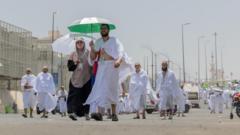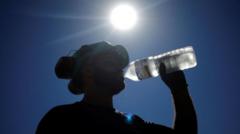To address the oppressive climate, where temperatures are expected to soar to 44°C (111°F), Saudi officials have planted thousands of trees and established hundreds of cooling units around pilgrimage routes. Strict regulations now prohibit children under 12 from participating, and a warning has been issued that unregistered pilgrims could face hefty fines and a decade-long entry ban. Over 269,000 individuals have already been denied access to Mecca due to non-compliance.
A significant proportion of last year's fatalities stemmed from unregistered pilgrims, who lacked air-conditioned accommodations or proper transport, resulting in dire conditions during peak heat. Many entrants to the region could not afford official Hajj packages, which range from $4,000 to $20,000 based on various factors. As a remedy, the Saudi health ministry has advised pilgrims to heed heat mitigation guidelines, including avoiding sun exposure during peak hours, utilizing umbrellas, and staying hydrated.
In preparation for the pilgrimage, shaded areas have been expanded by over 50,000 square meters (12 acres), and the Grand Mosque's cooling system—a facility noted as the world's largest—has been activated. Innovations such as rubberized and temperature-controlled roads, along with AI-managed drone fleets for crowd control, have also been introduced. The Hajj remains a sacred journey for Muslims worldwide, making these safety measures critical for a successful event.
On the first day of Hajj, male pilgrims donned traditional white cloths, entering a state of Ihram, while women dressed modestly. The rites included circling the Kaaba in the Grand Mosque and traversing between the hills of Safa and Marwa before spending the night in Mina. Plans for the continuation of the pilgrimage will lead participants to Mount Arafat, honoring the traditional practices established in Islam.
A significant proportion of last year's fatalities stemmed from unregistered pilgrims, who lacked air-conditioned accommodations or proper transport, resulting in dire conditions during peak heat. Many entrants to the region could not afford official Hajj packages, which range from $4,000 to $20,000 based on various factors. As a remedy, the Saudi health ministry has advised pilgrims to heed heat mitigation guidelines, including avoiding sun exposure during peak hours, utilizing umbrellas, and staying hydrated.
In preparation for the pilgrimage, shaded areas have been expanded by over 50,000 square meters (12 acres), and the Grand Mosque's cooling system—a facility noted as the world's largest—has been activated. Innovations such as rubberized and temperature-controlled roads, along with AI-managed drone fleets for crowd control, have also been introduced. The Hajj remains a sacred journey for Muslims worldwide, making these safety measures critical for a successful event.
On the first day of Hajj, male pilgrims donned traditional white cloths, entering a state of Ihram, while women dressed modestly. The rites included circling the Kaaba in the Grand Mosque and traversing between the hills of Safa and Marwa before spending the night in Mina. Plans for the continuation of the pilgrimage will lead participants to Mount Arafat, honoring the traditional practices established in Islam.




















